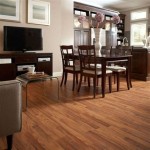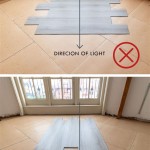White Oak Laminate Flooring 12mm: A Comprehensive Overview
White oak laminate flooring in a 12mm thickness represents a popular flooring choice for homeowners and businesses alike. This material offers a compelling blend of aesthetic appeal, durability, and affordability, making it a versatile option for a wide range of interiors. The combination of the classic look of white oak with the practical benefits of laminate and the added robustness of a 12mm thickness creates a flooring solution that is both attractive and long-lasting.
Laminate flooring, in general, is a multi-layered synthetic flooring product fused together through a lamination process. It typically consists of a core layer made of high-density fiberboard (HDF) or medium-density fiberboard (MDF), topped with a decorative photographic layer that mimics the appearance of natural materials like wood, stone, or tile. A clear, protective wear layer is then applied over the decorative layer to provide resistance to scratches, dents, and fading. The 12mm thickness, in this specific case, refers to the overall thickness of the laminate plank, impacting its underfoot feel, sound insulation, and structural integrity.
White oak laminate flooring specifically attempts to replicate the look and feel of genuine white oak hardwood. White oak is a highly valued species of wood known for its durability, distinctive grain patterns, and light, neutral color tone. This makes it a desirable choice for creating bright, airy, and inviting spaces. However, solid white oak hardwood flooring can be expensive and requires specialized installation and maintenance. White oak laminate provides a cost-effective and easier-to-maintain alternative that captures the aesthetic essence of real white oak.
Aesthetic and Design Considerations
The aesthetic appeal of white oak laminate flooring stems primarily from its ability to mimic the natural beauty of white oak hardwood. Manufacturers employ advanced printing technologies to create realistic wood grain patterns and textures on the decorative layer of the laminate planks. This can include variations in color, knots, and other natural imperfections that are characteristic of real wood. The result is a flooring surface that closely resembles the look of solid white oak flooring, but at a fraction of the cost.
The light, neutral color of white oak laminate makes it a highly versatile design choice. It complements a wide range of interior styles, from traditional to contemporary, and can be paired with various wall colors, furniture styles, and décor elements. The light tone of the flooring can help to brighten up a room and create a sense of spaciousness. It also provides a neutral backdrop that allows other design features to stand out.
White oak laminate flooring is available in a variety of plank sizes and formats. Some manufacturers offer wider planks for a more modern and luxurious look, while others offer narrower planks for a more traditional or rustic feel. The planks can also be installed in different patterns, such as straight lay, staggered patterns, or herringbone patterns, to create unique visual effects. The flexibility in plank size and installation pattern allows homeowners to customize the look of their flooring to suit their individual tastes and preferences.
Furthermore, the surface texture of the laminate can also contribute to its aesthetic appeal. Some manufacturers offer embossed-in-register (EIR) texturing, which means that the texture of the laminate surface aligns with the printed wood grain pattern. This creates a more realistic and tactile feel, further enhancing the resemblance to real wood. Other texturing options may include smooth surfaces, hand-scraped textures, or distressed textures, each offering a different aesthetic effect.
Durability and Performance
The 12mm thickness of white oak laminate flooring is a significant factor contributing to its overall durability and performance. Compared to thinner laminate options, a 12mm laminate plank offers increased resistance to impacts, indentations, and wear and tear. This makes it a suitable choice for high-traffic areas, such as hallways, living rooms, and kitchens, where the flooring is likely to be subjected to heavy use.
The wear layer of the laminate is another critical factor in determining its durability. The wear layer is a clear, protective coating that is applied to the top surface of the laminate plank. It is designed to resist scratches, stains, fading, and other types of surface damage. The thickness and composition of the wear layer can vary depending on the manufacturer and the specific product. A thicker, more durable wear layer will provide greater protection against wear and tear and extend the lifespan of the flooring.
Laminate flooring is also known for its resistance to moisture. While it is not waterproof, it is generally more resistant to water damage than solid hardwood flooring. The top layer of the laminate is typically water-resistant, preventing spills from penetrating the surface. However, it is important to clean up spills promptly to prevent moisture from seeping into the seams between the planks. Some manufacturers offer waterproof laminate flooring options that are specifically designed for use in areas where moisture is a concern, such as bathrooms and laundry rooms.
The composition of the core layer, typically HDF or MDF, also plays a role in its durability and performance. HDF is denser and more resistant to moisture than MDF, making it a preferred choice for high-quality laminate flooring. The core layer provides structural support to the laminate plank and helps to prevent it from warping or buckling under pressure.
In conclusion, the 12mm thickness and the quality of the wear layer and core layer all contribute to its durable performance. It's essential to consider these factors when selecting white oak laminate flooring to ensure that the product is suitable for the intended application and will withstand the demands of everyday use.
Installation and Maintenance
One of the key advantages of laminate flooring is its ease of installation. Most laminate flooring products are designed with a click-lock system, which allows the planks to be easily snapped together without the need for nails or glue. This makes it a popular choice for DIY enthusiasts who want to install their own flooring. However, it is important to follow the manufacturer's instructions carefully to ensure a proper installation.
Before installation, it is essential to prepare the subfloor properly. The subfloor should be clean, level, and dry. Any unevenness or imperfections in the subfloor can cause the laminate flooring to buckle or warp over time. A vapor barrier may also be required to prevent moisture from migrating up from the subfloor and damaging the laminate. This is particularly important in basements or other areas where moisture levels are high.
Once the subfloor is prepared, the laminate planks can be installed following the manufacturer's instructions. It is important to leave an expansion gap around the perimeter of the room to allow for expansion and contraction of the flooring due to changes in temperature and humidity. This will prevent the flooring from buckling or warping.
Maintaining white oak laminate flooring is relatively simple. Regular sweeping or vacuuming is all that is typically required to remove dirt and debris. For more thorough cleaning, a damp mop can be used with a mild detergent specifically designed for laminate flooring. It is important to avoid using excessive amounts of water, as this can damage the flooring. Avoid using abrasive cleaners or scouring pads, as these can scratch the surface of the laminate.
To prevent scratches and dents, it is recommended to use furniture pads under the legs of furniture. Avoid dragging heavy objects across the floor. Place mats or rugs in high-traffic areas to protect the flooring from wear and tear. With proper installation and maintenance, white oak laminate flooring can provide years of beautiful and durable performance.
Additionally, consider the AC rating of the laminate. The Abrasion Class (AC) rating indicates the laminate's resistance to abrasion, impact, and staining. Higher AC ratings signify greater durability. For residential use, an AC3 rating is generally sufficient, while commercial applications may require an AC4 or AC5 rating.
Finally, proper acclimation of the laminate planks is crucial before installation. Store the unopened boxes of laminate in the room where they will be installed for at least 48 to 72 hours to allow the planks to adjust to the room's temperature and humidity. This will help to minimize expansion and contraction after installation and prevent gapping or buckling.

Series Woods Professional 12mm Laminate Flooring White Oak

Series Woods Professional 12mm Laminate Flooring White Oak

Albero White Oak 12mm Laminate Flooring 1 48m2 Wickes Co

12mm Villa White Oak Laminate Sample

Rip Oak White Robusto Villa 12mm Laminate Flooring Leader Floors

Dream Home 12mm Valley Crest Oak W Pad Waterproof Laminate Flooring 8 03 In Wide X 47 64 Length Ll

Luxurious Swedish 12mm White Oak Laminate Flooring 22 78psqm 1036 18 Arks Factory Flooring4discount Com

Kronotex Villa 12mm Gala Oak White Laminate Flooring Flooringrevolution

Xtra Step 12mm White Oak Xs105 Water Resistant Laminate Flooring

Luxury 12mm Ac5 White Oak Laminate Flooring Dfd
Related Posts








